Tags
Cormorant, Cormorant breeding plumage, cormorant with white head, fulmar, Great cormorant, grey seals, Northern Wheatear, phalocrocorax carbo, shag
April 5th
I’m home for a few days and feel the need to catch up on what’s happening here before setting off again at the weekend. I decided to head for the Little Orme, the best place I know locally to see a great variety of wildlife in a short space of time. Spring is generally late arriving this year and usually comes even later here than to other more sheltered sites, so I hoped I wouldn’t have missed too much.
The blend of habits on this limestone headland make it special, if not unique as it provides for the needs of diverse species of birds from House sparrows to Chough and Fulmars and it supports some lovely lime-loving wildflowers. The human influence on the site is most evident in its dramatic reshaping by quarrying, there is also a farm with some enclosed fields and sheep that are allowed to range freely. Houses butt closely up against its Penrhyn Bay boundary and it is rare to come here and not see people out walking. Today I noticed that someone has hung a bird-feeder up in a small tree just inside the site. There was a Great tit and several House sparrows taking the seed on offer, but not surprisingly they were seen off by Jackdaws.
It’s the Easter holidays, so as I’d expected there were a good few people here, families enjoying the fresh air and sunshine, the usual dog-walkers and a few dog-less ones too. 
There were people clambering on the rock beside Angel Bay. Below them a trio of Herring gulls set up a raucous racket. I couldn’t be sure what had set them off, but maybe they were objecting to people invading their space.
On a rock jutting out into Angel Bay another pair sat calmly, heads turned towards the group of grey seals down below them, some of which were also making a bit of noise.
They were a lovely little group of adults with their young ones. Some were trying their best to relax while others were restlessly in and out of the water. At least two more were swimming around out in the bay.
A single Guillemot was also cruising around on the water but didn’t stay visible for long, soon diving and swimming away underwater hunting fish.
When I first entered the site I was surprised not to see or hear Fulmars on the high cliff that usually has several pairs nesting, or preparing to nest on its ledges by this time. There were one or two flying around the cliffs nearer to the sea though, so I set off up the steep path to the old quarry field to see if there were signs of nesting there.
I’m sure this upward slope gets steeper each time I climb it! I have to remind myself it wasn’t built for walking up. Back in the days when quarrying was in full swing there were rails from its bottom end up to what was a quarry face; trucks were loaded with stone then lowered down and returned empty using heavy-duty winding gear – the remains of which still stands as a monument to past industry at the top of the track. Care is needed when using this track, it’s slippery when wet and dry, especially going down.
I was pleased to have a few excuses to stop for breath to photograph celandines and primroses nestled down amongst the dead stems of grass and fronds of bracken. There were daisies on the grassy slopes nearer the top, one with a fly sunbathing in its centre.
One of the limestone specialist plants, the Carline thistle still holds it shape perfectly, seedheads still intact, although it is completely dry and colourless.
Phew! Finally at the top. I walked around the cliff edge, not too close as I could see that the winter weather has further eroded away the softer layers of soil and loose stone that covers the bedrock.
Two Fulmars sat quietly in a sheltered recess in the cliff-face. I’m fairly sure they were a pair as they were sitting close together and occasionally touching one another, I’m loathe to say affectionately, but it did look that way!
Fulmars are noisy birds though and it wasn’t long before something set them off. I imagine their spot is a good one and probably coveted by others, so will take a fair amount of defending.
They have a visitor who clings onto the rock nearby and stays for a while despite being squawked at. Perhaps the noise was by way of a greeting.
I was surprised it managed to cling on with those flat webbed feet. It was a lovely view for me though, they are such pretty gulls to look at. Shame about the raucous voice and the habit of snorting out salt water and other debris down their tubular noses!
Another bird made several close aerial passes but didn’t stop. I left them to it; seems like they’ve got enough to contend with.
I take the ‘short-cut’ scramble up the rocks to reach the higher level of the cliffs: not the recommended route, especially for grandmothers encumbered with cameras in hand that should know better! I got there unscathed though and enjoyed a good view back down onto the quarry from the top.
I was heading for the outcrops of the headland used as nest sites by the Cormorant and Guillemot colonies, although I suspected I may be a bit early. I like the view over to the Great Orme from here; it looks like an island.
TREASURE IN THE GRASS
Although grazed by sheep and rabbits and exposed to the worst of the elements here, wildflowers can be found tucked down in the turf particularly around exposed rock. I spotted this little patch of white flowers, which on closer inspection turned out to be two different species. I couldn’t name either, but very kindly Suzanne posted a comment and suggested the tiny one with red-tinged fleshy leaves may be Rue-leaved saxifrage and the bigger more droopy one with fine stems as Common Whitlow grass. I will go back and get some better photographs of the little treasures.
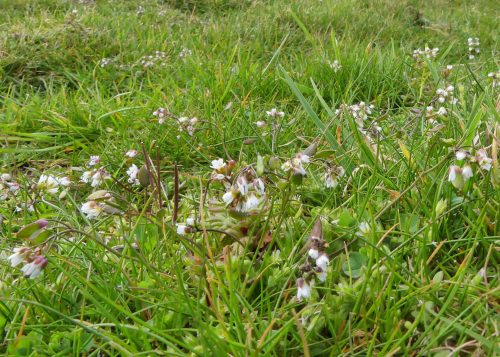
Common Whitlow grass-Erophila verna
I disturbed a flock of Jackdays that had been foraging in the clifftop grass. In my picture the buildings on the top of the hill in the background are on the Great Orme Summit.
Looking over the edge of the cliff for signs of my target birds I saw what I thought were Cormorants until I saw the raised crest of one and realised they were Shags.They were far below me, so the quality of the image is not great, but you can see what they are from it.
There were no signs of either Cormorants or Guillemots on this side of the cliff so I carried on walking towards its other more easily visible side. I hadn’t gone far when I spotted a bird flitting about between rocks near the edge; a handsome male Northern Wheatear. It was slightly below me behind a bit of a ridge, so partly hidden from its view I managed to watch it for some time with out disturbing it.
CORMORANT COLONY
As I’d thought it was a bit early for the Cormorants to have begun nesting, but there were a a few birds hanging around on the cliff.
Two birds higher up on a ledge definitely have their breeding plumage – the white patches on their thighs is clearly visible. They also have white heads which is more unusual amongst the Cormorants we usually see here. They were adopting some strange poses too, but may just have been making the most of a warm spot.
I went back down the hill following the paths to complete the circuit of this side of the headland. I realised I hadn’t met a single sheep out on the cliffs when I saw the first ones with lambs still in the field.
The gorse is coming into full golden bloom now and as always I couldn’t resist stopping several times to inhale its gorgeous uplifting scent.

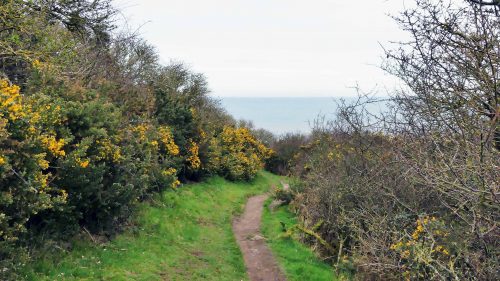 I heard a Robin singing and did spied him framed by prickly branches.
I heard a Robin singing and did spied him framed by prickly branches.
Picking my way carefully down the rocky slope past the sheep field I heard a Greenfinch singing from within the tangle of shrubby vegetation. Tauntingly close by, I stood and searched for a while but couldn’t pinpoint him. It was good to hear him though; as I said in the most recent post about the Great Orme, Greenfinches are not that common nowadays.
The hawthorn tree that marks the junction of paths going up, down or on towards the Rhiwleddyn Reserve, is still without leaves but green with lichen. It’s a lovely tree, having a perfect full rounded shape and spreading evenly in all directions; unusual here where the hawthorns are mostly forced into some weird and wonderful shapes by exposure to the strong winds.
The slope going down safely negotiated, I walked towards the way out, stopping only to debate whether to walk through the man-made ‘gorge’ that leads through to another way in/out at its far end. It can be a good place to spot Stonechats, which I hadn’t seen today, but there were quite a few big puddles of water and it looked muddy, so I gave it a miss.
Looking down into the ‘gorge’ from the path above, I stopped to listen to a Blackbird singing from a small ash tree growing down there. They have such a wonderful laid-back, tuneful and fluent song that is so easy on the ear.
Several Jackdaws were more intent on foraging for their supper.
A rotund little Dunnock singing his pretty little song from amongst the tangle of bramble stems at the side of the steps finished off my walk perfectly.
Weather: Sunny but cool
Birds: Herring gull; Fulmar; Guillemot; Cormorant; Shag; Carrion crow; Magpie; Wood pigeon; Jackdaw; Blackbird; Robin; Greenfinch (singing); House sparrow; Dunnock; Great tit; Wren; Northern Wheatear
Insects: Very few; too cold for butterflies
Wildflowers: Alexanders; Gorse; Primrose; Common Daisy; Lesser celandine; Carline thistle (dried); Common Whitlow grass









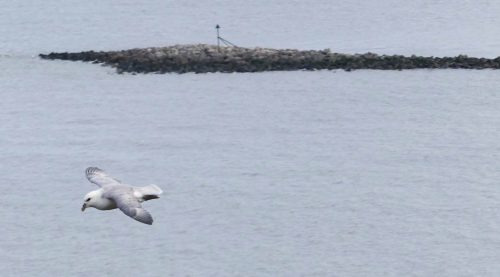






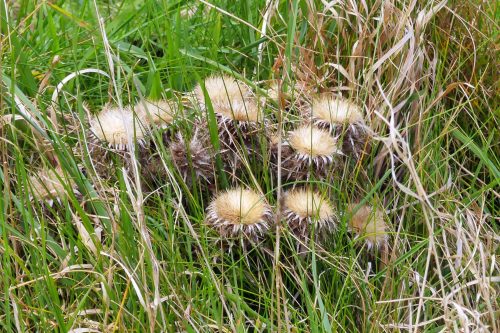


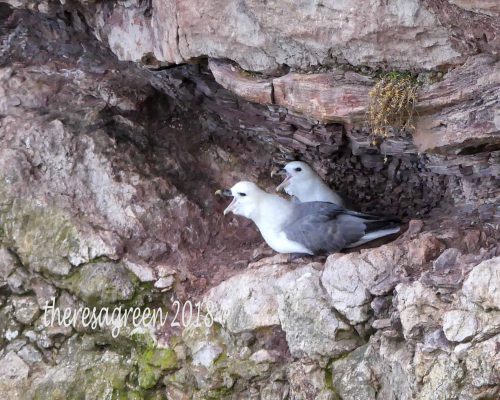
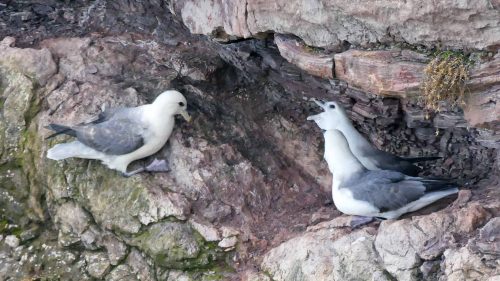
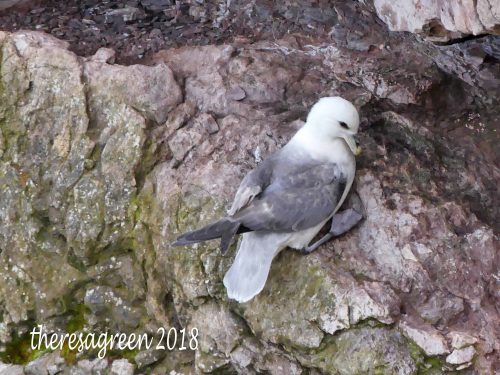
















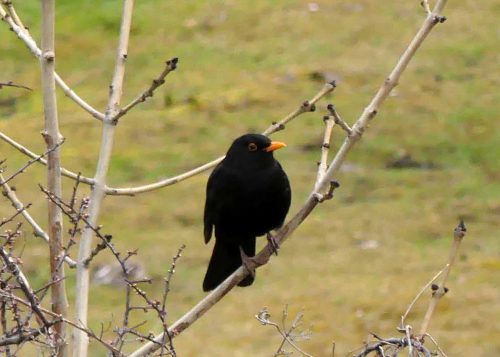

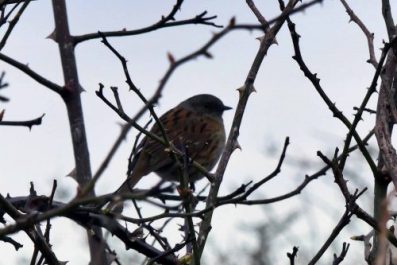
Thank you John, the Fulmars are delightful birds and it’s not often you get the opportunity to watch their behaviour so closely, although I’m still not entirely sure what they were up to. We have an army of ‘twitchers’ that pursue accidental bird visitors here too. I often wonder what inspires them to travel sometimes hundreds of miles for a possible quick glimpse of a bird that is probably ‘common’ in it’s home country!
LikeLiked by 1 person
Lovely fresh-air post. I really enjoyed the photographs of the Fulmars. It’s interesting to note what species we share with you such as those Grey Seals. The Northern Wheatear is strictly an accidental visitor over here, and the presence of one will attract more birders than birds.
LikeLiked by 1 person
Thank you, I’m always happy to have your company! Spring continues to start-stop-start here Pat, we’ve had a few beautiful warm sunny days followed by torrential rain and now cooler again. Nature is trying hard to catch up though and our countryside becoming greener by the day. I hope you don’t have have to wait too much longer for it to reach you.
LikeLike
Spring is slowly arriving at the Little Orme. I felt like I was walking along beside you and gasping at the erosion and smiling at the interaction among the nesting Fulmars. Stunning photography. It has been a very cold and wet spring here, with occasional snow flurries last week. I am so ready for spring.
LikeLiked by 1 person
Hello Theresa. Thanks again for all your lovely photo`s. I have been to lovely Tenby. But not as lucky as you being able to see and photo so much wonderful nature. Thank you. x
LikeLiked by 1 person
Hello Paula and thank you, I do feel privileged to have access to some wonderful nature. I love Tenby too, haven’t been for a good few years now, but used to go for days out most summers with my children when they were younger.
LikeLike
Thank you, it is an exceptional place with a character all of its own. It seems that Spring has been late getting going in most places this year, hope you are glorying in it now.
LikeLike
What a range of creatures and plants. Lovely to see your local nature trail and we can begin to celebrate Spring. Has been rainy and cold for a while in our part of Spain too.
LikeLiked by 1 person
Thanks Shazza. There were a lot of people about that day and Spring still waiting to get going, so I was happy to see as much as I did.
LikeLike
What wonderful photos again. An informative look at the wildlife on the little orme. 🙂
LikeLiked by 1 person
Hello Theresa,
Lovely pictures of some of the Little Orme’s wildlife. I think the two plants with small white flowers that you saw might be Rue-leaved saxifrage (with the reddish fleshy leaves) and possibly Whitlow grass..
LikeLiked by 1 person
Thank you Suzanne, especially for identifying the pretty little flowers for me. I’ll update the post and try to go back and get some better photographs of them now I know what I’m looking for and where to find them.
LikeLike